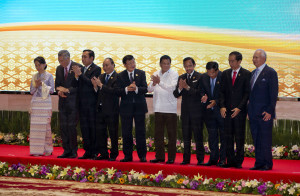
Leaders of the Association of Southeast Asian Nations (ASEAN) applaud after posing for a group photo at National Convention Center in Vientiane, Laos, Tuesday, Sept. 6, 2016. Leaders from left, Myanmar’s State Counsellor and Foreign Minister Aung San Suu Kyi, Singapore’s Prime Minister Lee Hsien Loong, Thai Prime Minister Prayuth Chan-ocha, Vietnam’s President Tran Dai Quang, Laos Prime Minister Thongloun Sisoulith, Philippine’s President Rodrigo Duterte, Brunei Foreign Minister and Prime Minister Sultan Hassanal Bolkiah, Cambodian Prime Minister Hun Sen, Indonesia’s President Joko Widodo and Malaysia’s Prime Minister Najib Razak. (AP Photo/Gemunu Amarasinghe)
MANILA — Leaders of the Association of Southeast Asian Nations and China have agreed to step up measures to stop military tensions in the disputed waters of South China Sea through the Code of Unplanned Encounters at Sea (CUES) and a hotline that alerts parties on skirmishes including military incursions particularly of claimants.
Both parties supported the creation of a hotline to respond to maritime emergencies in the implementation of the Declaration of Conduct of Parties in the South China Sea (DOC). The DOC adopted by Asean and China in 2002 commits parties “to exercise restraint and prevent tensions” in the disputed waters.
“We remain committed to the full and effective implementation of the DOC in its entirety and working substantively towards the early adoption of a Code of Conduct in the South China Sea (COC) based on consensus,” said the Asean-China joint communiqué signed on Sept. 7, 2016 during the Asean Summit in Vientiane, Laos.
The Asean-China joint communiqué also stressed that parties “welcome the establishment of the Guidelines for Hotline Communications among Senior Officials of the Ministries of Foreign Affairs of ASEAN Member States and China in Response to Maritime Emergencies in the Implementation of the DOC.”
But as leaders signed the joint communiqué at the Asean Summit in Laos with the aim to bring peace and security in the disputed waters, the Philippines’ Department of National Defense (DND) said six Chinese military vessels were spotted in Scarborough shoal, off the coasts of Zambales province.
The DND claimed that Chinese vessels were dredging sands and transferring them from one area to another.
According to the Philippine Department of National Defense (DND), this is one of the Chinese vessels in Scarborough Shoal, one of the disputed areas of South China Sea. Photo from DND.
The joint communiqué by Asean and China officials stated that parties agreed “to resolve the territorial and jurisdictional disputes by peaceful means, without resorting to the threat or use of force, through friendly consultations and negotiations by sovereign states directly concerned, in accordance with the universally recognized principles and international law, including the 1982 United Nations Convention on the Law of the Sea (UNCLOS).”
The Asean — composed partly of claimant countries such as the Philippines, Vietnam, Brunei and Malaysia — also agreed with China to respect freedom of navigation in and overflight above the South China Sea. Other members are Indonesia, Thailand, Myanmar, Cambodia, Laos and Singapore.
“We also undertake to exercise self-restraint in the conduct of activities that would complicate or escalate disputes and affect peace and stability,” said the Asean-China Joint Communique signed on September 7, 2016 in Laos.
The Permanent Court of Arbitration in The Hague has dismissed China’s historical claims over 90 per cent of South China Sea waters through its nine dash line. The court’s ruling on July 12 also said China has violated the United Nations Convention on the Law of the Sea every time it prevented Filipino fishermen from fishing in the waters of Scarborough and Reed bank in Palawan shores.
The joint communiqué of Asean-China also expressed full support to the full and effective implementation of the Asean-China Free Trade Area (ACFTA) that has been designed to facilitate free flow of goods and services .
Both parties also agreed to step up work for the conclusion of the Regional Comprehensive Economic Partnership (RCEP) that has been facilitating trade and services between Asean members and six dialogue partners — China, Japan, South Korea, India, Australia and New Zealand. SFM